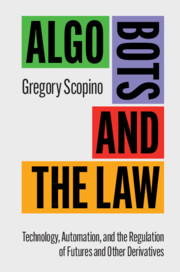Book contents
- Reviews
- Algo Bots and the Law
- Algo Bots and the Law
- Copyright page
- Contents
- Preface
- Introduction
- 1 Key Concepts: Algorithms, Artificial Intelligence, and More
- 2 Economic Definitions of Common Derivatives
- 3 Legal and Regulatory Definitions of Derivatives and Other Financial Instruments
- 4 FinTech: From Science Fiction to Non-Fiction
- 5 The Regulatory Framework for the US Derivatives Markets
- 6 Gateways to the Futures Markets – FCMs
- 7 Collective Investment Vehicles and Investment Advisors
- 8 Salespeople, Supervisors, Owners, and Enumerated Others
- 9 Trading Floor Denizens
- 10 Regulating Digital Intermediaries
- 11 States of Mind: From Zero to Specific Intent
- 12 Market Manipulation: Then and Now
- 13 Fraud Is Many Things (for Humans and Robots)
- 14 Disruptive Trading Practices
- 15 Spoofing: Market Disruption Made Easy by Technology
- 16 Adequately Supervising the Overseers of Algo Bots
- 17 Flash Events
- 18 Algo Bots All over the World
- 19 Conclusion
- Index
12 - Market Manipulation: Then and Now
Published online by Cambridge University Press: 02 October 2020
- Reviews
- Algo Bots and the Law
- Algo Bots and the Law
- Copyright page
- Contents
- Preface
- Introduction
- 1 Key Concepts: Algorithms, Artificial Intelligence, and More
- 2 Economic Definitions of Common Derivatives
- 3 Legal and Regulatory Definitions of Derivatives and Other Financial Instruments
- 4 FinTech: From Science Fiction to Non-Fiction
- 5 The Regulatory Framework for the US Derivatives Markets
- 6 Gateways to the Futures Markets – FCMs
- 7 Collective Investment Vehicles and Investment Advisors
- 8 Salespeople, Supervisors, Owners, and Enumerated Others
- 9 Trading Floor Denizens
- 10 Regulating Digital Intermediaries
- 11 States of Mind: From Zero to Specific Intent
- 12 Market Manipulation: Then and Now
- 13 Fraud Is Many Things (for Humans and Robots)
- 14 Disruptive Trading Practices
- 15 Spoofing: Market Disruption Made Easy by Technology
- 16 Adequately Supervising the Overseers of Algo Bots
- 17 Flash Events
- 18 Algo Bots All over the World
- 19 Conclusion
- Index
Summary
This chapter describes the elements of market manipulation claims and the history of market manipulation in connection with the US markets for derivatives. From the beginning of futures trading in the United States in Chicago shortly before the Civil War, rampant market manipulation and other abusive trading practices have threatened commodity futures trading. Accordingly, since the passage of the Grain Futures Act of 1922 (GFA), the precursor to the CEA of 1936 and the first federal effort to oversee US derivative markets (as discussed in greater detail in Chapter 2), the “central focus” and “essential goal” of the federal regulation of futures and derivatives has been “the punishment and prevention of … manipulation,” which is more specifically referred to as “price manipulation” or “market-power manipulation.” Perhaps more colorfully, a former CFTC chairman has compared market-power manipulation to situations “where the 800-pound gorilla simply invades the chicken coop.”
Keywords
- Type
- Chapter
- Information
- Algo Bots and the LawTechnology, Automation, and the Regulation of Futures and Other Derivatives, pp. 280 - 289Publisher: Cambridge University PressPrint publication year: 2020



